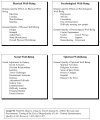Going with the flow: quality-of-life outcomes of cancer survivors with urinary diversion
- PMID: 20075694
- PMCID: PMC3530426
- DOI: 10.1097/WON.0b013e3181c68e8f
Going with the flow: quality-of-life outcomes of cancer survivors with urinary diversion
Abstract
Purpose: The purpose of this descriptive study was to describe health-related quality of life (HRQOL) concerns among cancer patients with continent urinary diversion (UD) and incontinent UD.
Subjects and settings: Study participants were accrued from members of the California United Ostomy Association and 2 cancer centers in Southern California.
Instrument: The City of Hope HRQOL-Ostomy Questionnaire (COHHRQOL-O) is a modified HRQOL measurement tool based on the original work done over a number of years by Grant and colleagues.
Methods: The COHHRQOL-O was mailed to 2,890 individuals. Of the 1,600 returns, there were 307 responses from patients with UD, indicating that they had a UD and a diagnosis that clearly indicated cancer.
Results: The majority of respondents were diagnosed with bladder cancer, and the average time since surgery was 9.5 years. While most patients reported being sexually active prior to UD, less than 27% resumed sexual activity after surgery. More than 75% of patients also reported difficulty in adjusting to their UD, with the majority reporting difficulty with urine leakage. Those who were incontinent reported a range of bothersome issues, such as skin problems around the UD, difficulties in managing UD care, fear of recurrence, financial worries, family distress, and uncertainty about the future.
Conclusions: The results of this study add to our understanding of how patients adjust to a UD and what problems and issues can occur, even years after the initial surgery. Mastering UD care is best done under the guidance of a WOC nurse, and access to WOC nurse is essential when problems occur.
Figures
Similar articles
-
Urinary diversion: long-term functional aspects.Urologia. 2014 Apr-Jun;81(2):65-75. doi: 10.5301/uro.5000071. Epub 2014 May 30. Urologia. 2014. PMID: 24874307 Review.
-
Quality of life following urinary diversion: Orthotopic ileal neobladder versus ileal conduit. A multicentre study among long-term, female bladder cancer survivors.Eur J Surg Oncol. 2019 Mar;45(3):477-481. doi: 10.1016/j.ejso.2018.10.061. Epub 2018 Oct 21. Eur J Surg Oncol. 2019. PMID: 30385155
-
Health related quality of life in patients treated with radical cystectomy and urinary diversion for urothelial carcinoma of the bladder: development and validation of a new disease specific questionnaire.J Urol. 2003 Nov;170(5):1926-30. doi: 10.1097/01.ju.0000092830.03247.ef. J Urol. 2003. PMID: 14532809
-
Evidence from the 'PROspective MulticEnTer RadIcal Cystectomy Series 2011 (PROMETRICS 2011)' study: how are preoperative patient characteristics associated with urinary diversion type after radical cystectomy for bladder cancer?Ann Surg Oncol. 2015 Mar;22(3):1032-42. doi: 10.1245/s10434-014-4029-3. Epub 2014 Aug 28. Ann Surg Oncol. 2015. PMID: 25164037
-
Comparison of health-related quality of life (HRQoL) between ileal conduit diversion and orthotopic neobladder based on validated questionnaires: a systematic review and meta-analysis.Qual Life Res. 2018 Nov;27(11):2759-2775. doi: 10.1007/s11136-018-1902-8. Epub 2018 Jun 20. Qual Life Res. 2018. PMID: 29926345
Cited by
-
Quality of life outcomes in patients living with stoma.Indian J Palliat Care. 2012 Sep;18(3):176-80. doi: 10.4103/0973-1075.105687. Indian J Palliat Care. 2012. PMID: 23439841 Free PMC article.
-
Behavioural profile and human adaptation of survivors after radical cystectomy and ileal conduit.Health Qual Life Outcomes. 2014 Apr 7;12:46. doi: 10.1186/1477-7525-12-46. Health Qual Life Outcomes. 2014. PMID: 24708662 Free PMC article.
-
Quality of Life in Patients Living with Stoma.Ethiop J Health Sci. 2021 Sep;31(5):993-1000. doi: 10.4314/ejhs.v31i5.11. Ethiop J Health Sci. 2021. PMID: 35221616 Free PMC article.
-
Factors Associated With Quality of Life Among People Living With a Stoma in Nonmetropolitan Areas.Nurs Res. 2021 Jul-Aug 01;70(4):281-288. doi: 10.1097/NNR.0000000000000511. Nurs Res. 2021. PMID: 33883499 Free PMC article.
-
The city of hope-quality of life-ostomy questionnaire: persian translation and validation.Ann Med Health Sci Res. 2014 Jul;4(4):634-7. doi: 10.4103/2141-9248.139355. Ann Med Health Sci Res. 2014. PMID: 25221719 Free PMC article.
References
-
- Jemal A, Siegel R, Ward E, et al. Cancer statistics, 2008. CA Cancer J Clin. 2008 Mar-Apr;58(2):71–96. - PubMed
-
- Krouse R, Grant M, Ferrell B, Dean G, Nelson R, Chu D. Quality of life outcomes in 599 cancer and non-cancer patients with colostomies. J Surg Res. 2007 Mar;138(1):79–87. - PubMed
-
- Grant M, Ferrell B, Dean G, Uman G, Chu D, Krouse R. Revision and psychometric testing of the City of Hope Quality of Life-Ostomy Questionnaire. Qual Life Res. 2004 Oct;13(8):1445–1457. - PubMed
-
- Porter MP, Penson DF. Health related quality of life after radical cystectomy and urinary diversion for bladder cancer: a systematic review and critical analysis of the literature. J Urol. 2005 Apr;173(4):1318–1322. - PubMed
-
- Nordstrom G, Nyman CR, Theorell T. Psychosocial adjustment and general state of health in patients with ileal conduit urinary diversion. Scand J Urol Nephrol. 1992;26(2):139–147. - PubMed
Publication types
MeSH terms
Grants and funding
LinkOut - more resources
Full Text Sources


